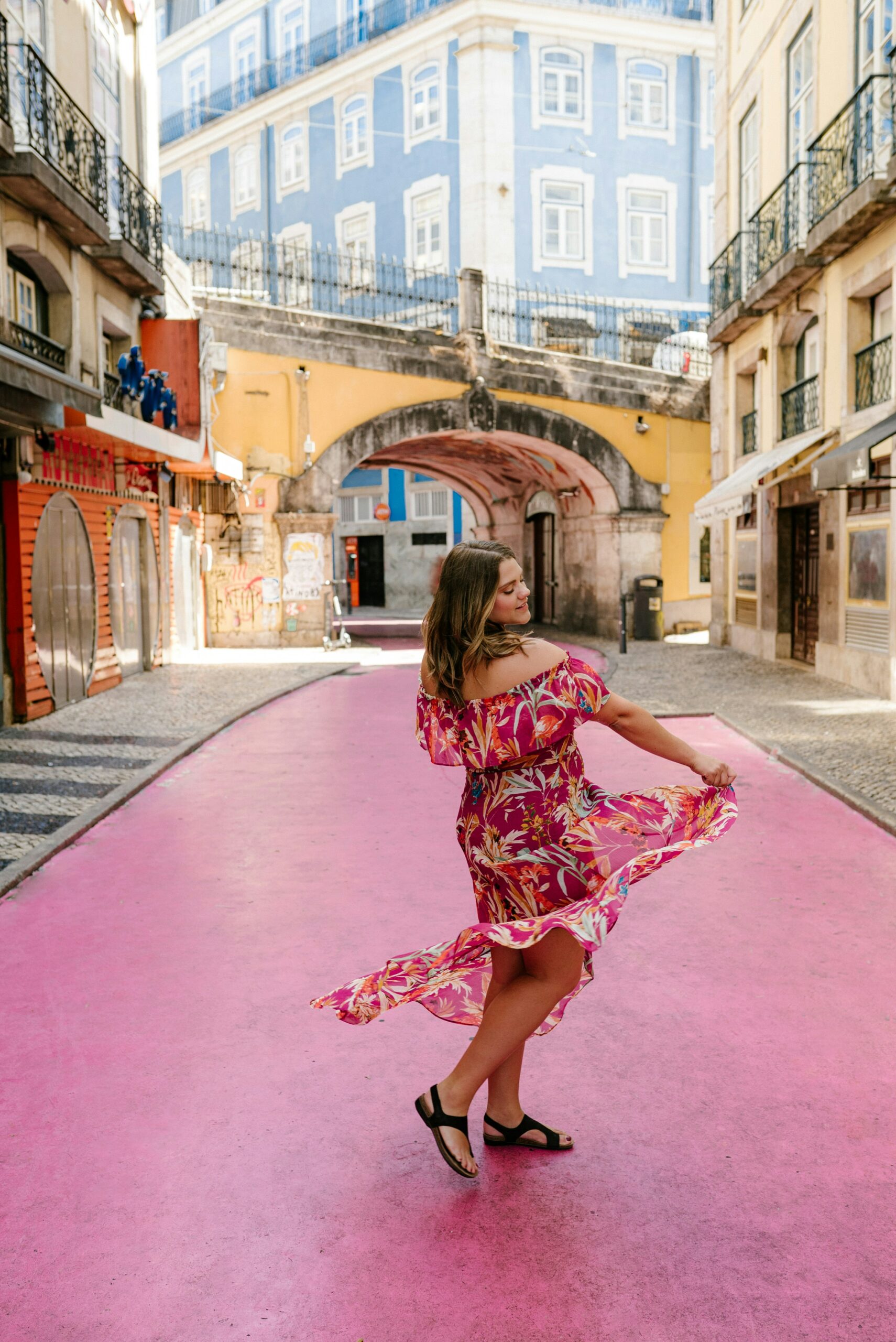Imagine this: you’re sipping a cocktail next to the beautiful Atlantic ocean, the jubilant sound of salsa your soundtrack as the waves roll in. To your right, dancers from all over the world are dancing salsa together. Suddenly, the rhythms quicken and the dancers’ bodies move in closer as bachata begins. After three more songs, bodies pressed together and pushing back, together and back, the percussive sounds of kizomba take over. Some dancers sit down next to you. Others get up and head excitedly to the dance floor. Welcome to Lisbon, Portugal, a melting pot of cultures and countries uniting in the spirit of dance.
Finding connection through the dance community in Lisbon
Aliénor Salmon left her job as a happiness researcher at the UN in 2016 to dance around the world, ultimately writing a book about her experience called . She has now settled in Lisbon and believes that “Lisbon offers a great discovery of different dance styles, especially for beginners who want to have a try and see what dance is for them without feeling intimidated.” When asked about the best dances to try in the city, she offered, “Lisbon has a strong tango scene, and a vibrant Forró community which have been my favorite so far. And without a doubt, Kizomba which is originally from Angola, became known to the world in Lisbon and is the next style I plan to learn.”
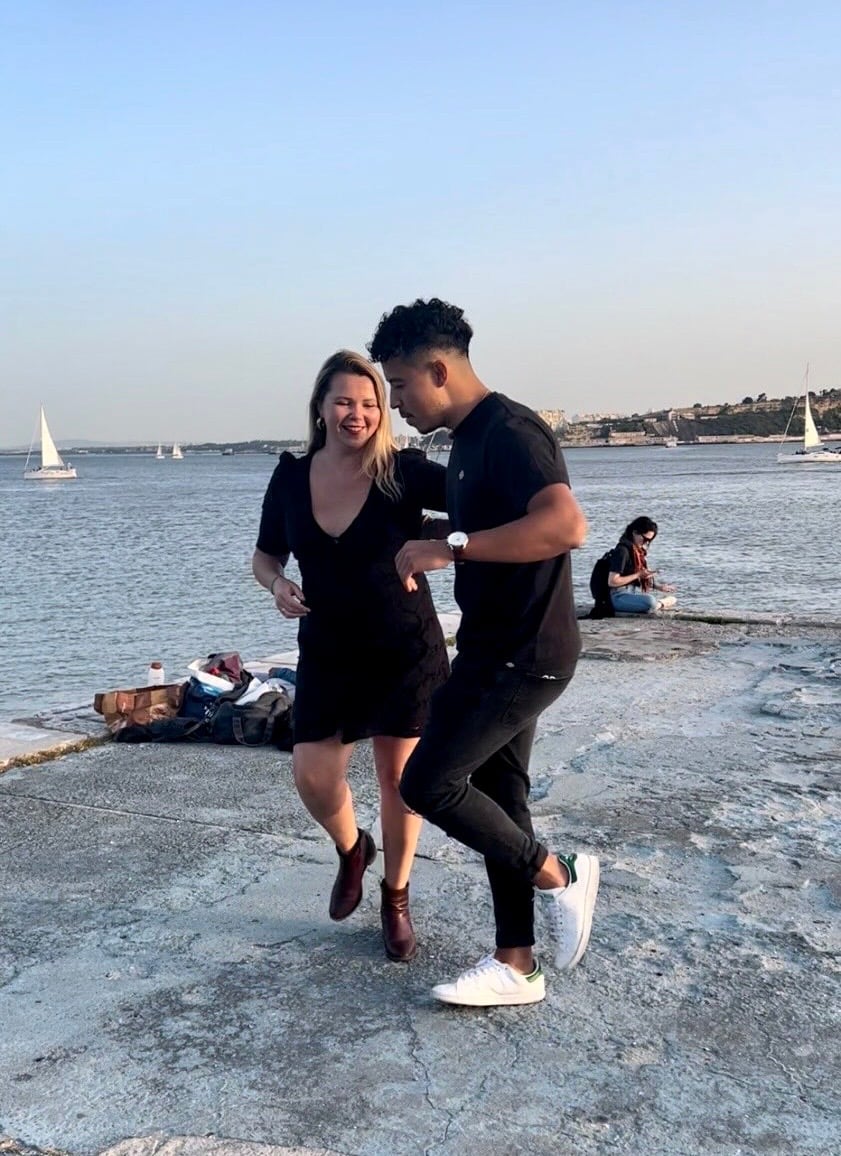
Fellow Lisbon resident Paula Nogueira from Brazil added, “Dancing is when you leave your mind behind and connect solely with your feelings, letting yourself be carried away by the rhythm of the music. It’s something that everyone of all ages can experience by taking a dance class.”
This guide will introduce you to 11 types of dance you can learn in Lisbon, highlighting the best places to take classes and the most popular weekly dance meetups. Whether you’re a seasoned dancer or have two left feet, Lisbon’s vibrant dance community welcomes everyone!
Where to Dance in Lisbon
1. Kizomba
Kizomba is a dance and music genre that originated in Angola in the late 20th century. It evolved from traditional Angolan dances like Semba and Kilapanga, incorporating elements from Caribbean zouk. Kizomba’s name, meaning “party” in Kimbundu, a Bantu language spoken in Angola, reflects its festive roots and social nature.
The style of Kizomba is characterized by a slow, sensual rhythm and close connection between partners. Dancers move smoothly with grounded steps, emphasizing a wave-like flow in their body movements. Its intimacy is marked by synchronized leg movements and a tight embrace, allowing for subtle lead and follow signals.
Internationally, Kizomba has grown, blending with other genres to form fusion styles like Urban Kiz. Despite its evolution, traditional Kizomba remains popular, celebrated for its emotional depth and cultural authenticity.
Lisbon is the world’s biggest hub for Kizomba outside of Angola and is considered as the place that first put Kizomba on an international stage. Many clubs and studios offer classes and social dancing nights. Barrio Latino in Santos often hosts Kizomba events. Additionally, Havan Way, near the waterfront, provides a fantastic atmosphere for dancers. For an authentic experience, check out Massa Club, frequented by locals and tourists alike. These venues cater to all levels, from beginners to advanced dancers.
Where to Learn Kizomba in Lisbon: Jazzy Dance Studios is a top choice for learning Kizomba in Lisbon. They offer classes for all levels, from beginner to advanced. There are four locations in Lisbon, but Santos is the biggest. UDance, a new dance school right next to the Jazzy Dance Santos location, also offers a large number of Kizomba classes. Escola Sabor & Dança (R. João de Freitas Branco) and Dance Factory Studios also offer several kizomba classes throughout the week.
Where to Dance Kizomba in Lisbon: In Lisbon, you are spoiled for choice when it comes to Kizomba meetups and places to dance. Dance Factory Studios has a Kizomba class followed by a dance social every Sunday at 10:30 am. Jazzy Dance Studios in Santos also has a Sunday social combining bachata, salsa, and kizomba tracks called DanSunday that starts at 5 pm and begins with dance classes followed by a social. Entry costs 6€ for Jazzy students and 8€ for Non-Students. Please bring cash.
B.leza Club near Cais do Sodré offers kizomba workshops and events, especially on Sundays starting from 7pm. Barrio Latino in Santos also hosts a number of different dance parties with Kizomba usually played on Saturdays along with bachata and salsa. Top Floor in Parque das Nações also hosts various kizomba and semba parties.
For more upcoming kizomba events, check here.
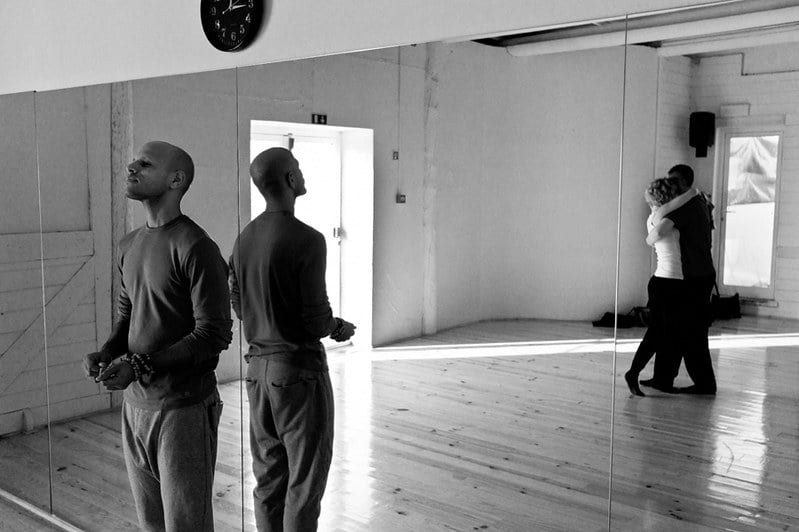
2. Salsa
Salsa originated in the Caribbean in the early 20th century, blending African, European, and indigenous influences. It evolved from earlier dance forms such as Son, Mambo, and Cha-cha-cha. Immigrants brought salsa to New York in the 1960s, where it quickly became popular.
Salsa is known for its energetic, vibrant style. Dancers move to a rhythm of quick steps and turns, often improvising. The dance is performed in pairs, with a strong emphasis on hip movement and fluidity.
The music driving salsa is as important as the dance itself, characterized by a mix of percussion, brass, and vocals. Salsa styles vary regionally, from the Cuban “Casino” to the New York “On2” style. Each style offers a unique interpretation, but all share the spirited essence of salsa.
In Lisbon, Portugal, Barrio Latino stands out for salsa enthusiasts, offering vibrant dance nights. Another hotspot is Havan Way, known for its Latin rhythms and dance lessons. For an authentic experience, visit Casa do Brasil de Lisboa, which hosts regular salsa events. Each venue provides a unique atmosphere, catering to dancers of all levels. Whether you’re a beginner or a seasoned dancer, Lisbon’s salsa scene is welcoming and exhilarating.
Where to Learn Salsa in Lisbon: Jazzy Dance Studios, UDance, Dance Factory Studios, Escola Sabor & Dança, and Academy World Dances all offer salsa classes for every skill level. Their experienced instructors make learning salsa accessible and enjoyable. Cuban salsa with Roberto Lauermann Val also comes highly recommended.
Where to Dance Salsa in Lisbon: Like kizomba listed above, you can dance salsa at Jazzy Dance Studios in Santos at DanSunday on Sundays starting at 5 pm. Barrio Latino in Santos also hosts salsa and bachata on one floor mostly on Saturday nights. Check out Top Floor in Parque das Nações as they host many Afrolatina events mixing salsa, bachata, and kizomba.
Information for one salsa party that has been going on for more than 20 years on Saturday nights near the ferry port in Calcilhas can be found here.
Since they specialize in salsa, it’s worth mentioning the monthly dance social at Academy World Dances (Rua Flores do Lima 8) on the first Friday of every month from 5:00 pm-11:30 pm. Entry is free for students and 5€ for non-students.
If you’re closer to the Cascais area, Rauly Rey hosts Musica Latina every Friday night at a Mexican Restaurant called El Senor.
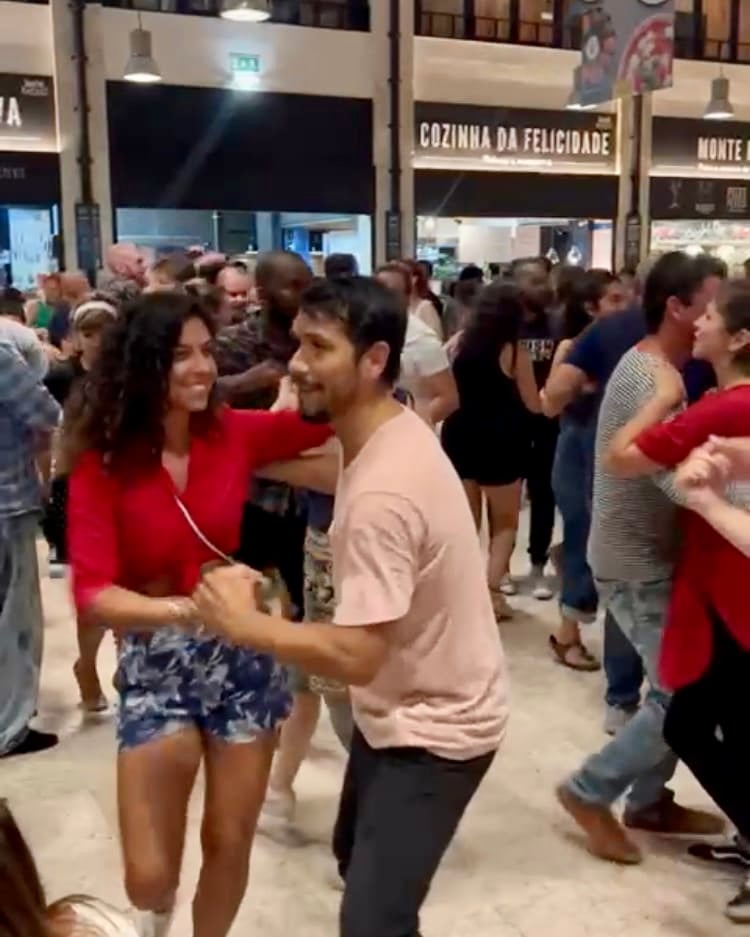
3. Bachata
Bachata originated in the Dominican Republic during the early 20th century, initially regarded as the music of the rural poor. It combines African, Indigenous, and European musical elements, reflecting a rich cultural fusion. The genre was often marginalized and associated with rural backwardness by the Dominican elite.
By the 1960s, bachata began gaining popularity, with artists like José Manuel Calderón recording the first bachata songs. Its style features distinctive guitar sounds, heartfelt lyrics, and a slow, sensual rhythm. Initially, it was confined to bars and brothels, which influenced its themes of heartbreak and melancholy.
The 1990s saw Bachata’s international breakout, with artists like Aventura modernizing the genre by blending it with pop and rock elements. This evolution introduced bachata to a global audience, leading to its inclusion in mainstream music. Today, bachata is celebrated for its emotive storytelling, intricate guitar work, and danceable beats, symbolizing a genre that has transcended its humble beginnings to gain worldwide acclaim.
Lisbon has a huge bachata scene with Barrio Latino being one of the standouts, especially on weekends. Another hotspot, Havan Way, offers weekly bachata classes and social dances. For a unique experience, the outdoor events at Miradouro de Santa Catarina combine breathtaking views with bachata rhythms. These venues cater to all levels, from beginners to advanced dancers, making Lisbon a bachata lover’s paradise.
Where to Learn Bachata in Lisbon: Bachata is another dance where you are spoiled for choice in Lisbon. Jazzy Dance Studios, UDance, Academy World Dances, and Dance Factory Studios all provide bachata classes for every skill level.
Where to Dance Bachata in Lisbon: In addition to Barrio Latino in Santos on Saturday nights already mentioned above and Top Floor in Parque das Nações also on Saturday nights, the Bachata Meetup group is incredibly active and will leave you with too little time and too many parties to attend. Join this community and never spend an evening alone again. This is also a good source for different types of bachata classes. Another very active Facebook group including all the latest dance event updates (including many on the international scene) is Bachata@Lisboa.
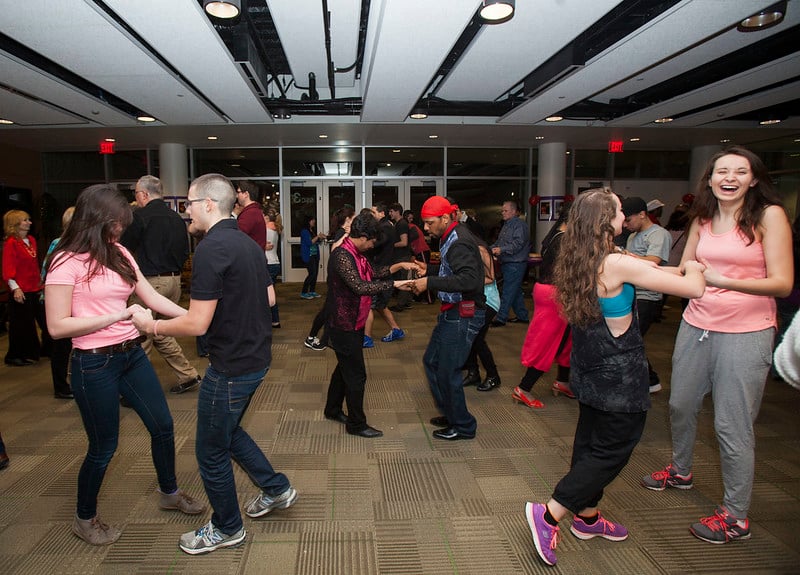
4. Forró
Forró is a popular genre of music and dance that originated in the Northeast of Brazil in the early 20th century. It encompasses various musical styles, reflecting the cultural diversity of its region of origin. The term “forró” itself was once thought to derive from the English phrase “for all,” though this theory is widely debated.
The music is characterized by its use of accordion, zabumba (a type of bass drum), and triangle. This trio creates a distinctive, lively rhythm that invites dancing. Forró’s dance style is equally engaging, featuring close partner dancing with rapid footwork and swirling movements, making it a vibrant aspect of Brazilian social gatherings.
Over time, forró has evolved into several subgenres, including baião, xote, and arrasta-pé, each with its unique characteristics but retaining the traditional forró essence. The genre has seen a resurgence in popularity, spreading beyond Brazil’s borders and gaining international recognition. Today, forró is celebrated in festivals around the world, showcasing its enduring appeal and the rich cultural heritage of Brazil.
Where to Learn Forró in Lisbon: If you’ve never been to Brazil or Portugal before, it’s likely that you may have never heard of forró, but this dance style is becoming ever more popular in Lisbon as the Brazilian community continues to grow and spread this beautiful dance around the world. The best place to learn forró in Lisbon is Espaço Baião, which is also a samba school. You can also follow them on Instagram here. Another great place to learn forró is Dança Mais by Camila Delphim in Campo de Ourique which comes highly recommended by local dancer Paula Nogueira.
Where to Dance Forró in Lisbon:
In addition to events happening at Espaço Baião, a forró social happens every Sunday at Avenida da Liberdade starting at 4 pm. From 4:30 pm-6:30 pm on Saturdays, you can also attend a forró social in Sintra.

5. Tango
Tango originated in the late 19th century in the lower-class districts of Buenos Aires, Argentina. It was a blend of African, Native South American, and European influences. Initially, it was a dance of the marginalized, but it gained popularity in the early 20th century, especially in Paris.
The style of tango is characterized by its dramatic and sensual nature. Dancers typically move in a close embrace, executing intricate footwork and leg movements. The music, often featuring a bandoneón, sets a melancholic and passionate tone.
Over time, tango evolved into various forms, including Argentine tango, Uruguayan tango, and ballroom tango. Each style has its own unique characteristics but shares the foundational elements of intimacy and emotion. Today, tango is celebrated worldwide, with numerous festivals dedicated to its preservation and innovation.
Where to Learn Tango in Lisbon: Check out the local tango schools Tango y Nada Más (R. Fernando Vaz 20B) and A Todo Tango (R. dos Fanqueiros 286). It’s best to call ahead or contact the schools via email before you stop by in person if you’d like to book a lesson. Many milongas (see in the next section) also offer basic classes just before the dance social begins.
Where to Dance Tango in Lisbon: In the tango world, a social tango dance meeting is known as a milonga, and Lisbon’s TangoLX website will keep you up to date on all of the latest milongas in Lisbon.
The Lusitango Lisbon Tango Festival takes place the last weekend of May each year and more info can be found on their Facebook page.
The Lisbon Tango Marathon will take place from September 26-30, 2024. More information can be found here.
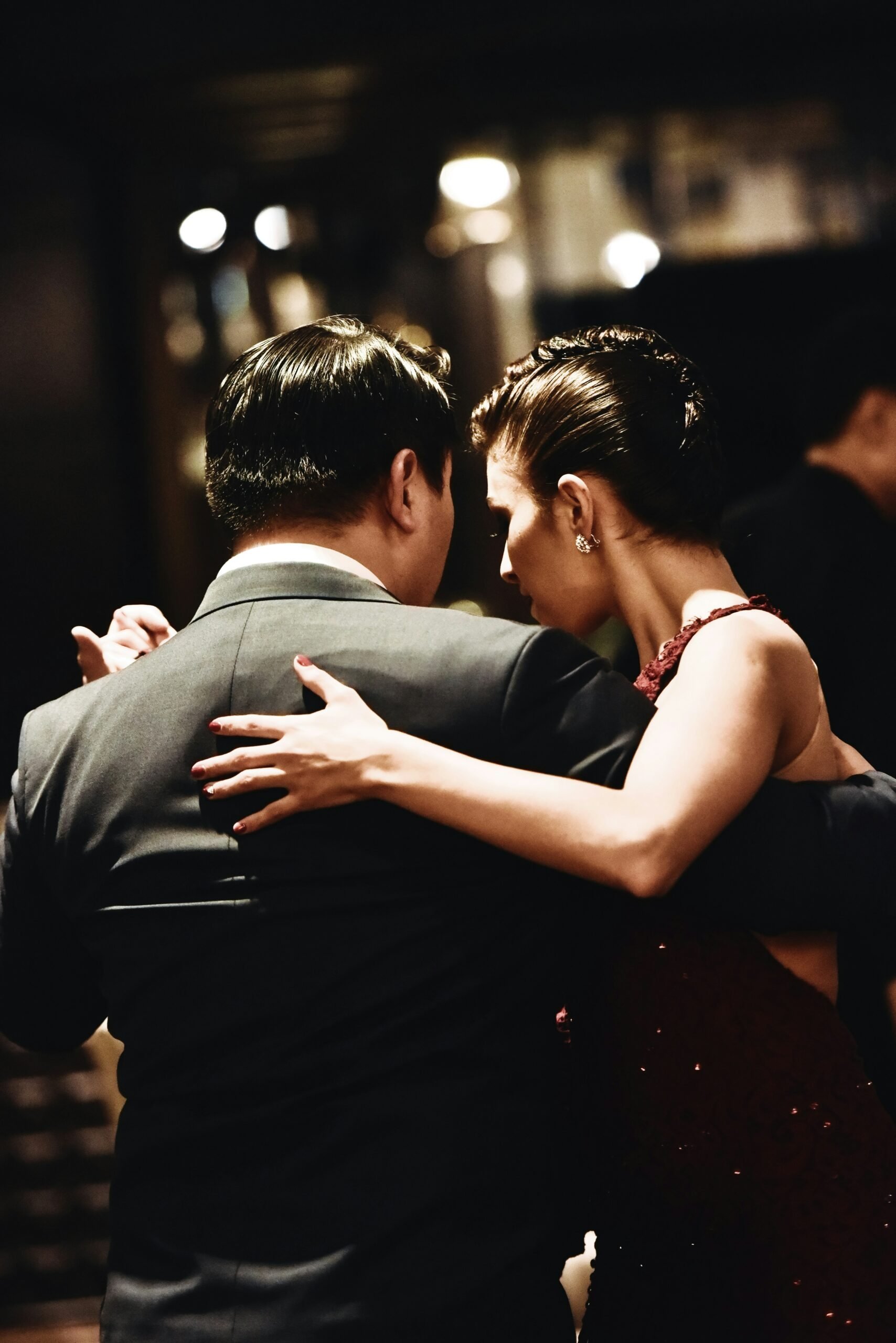
6. Hip-Hop
Hip-hop emerged in the 1970s in the Bronx, New York City, among African American and Latino youths. It started as a way to express themselves and their community’s struggles. DJing, rapping, graffiti, and breakdancing form hip-hop’s core elements.
The style of hip-hop is diverse, blending rhythm and poetry in rapping. Beats are crucial, often sampled from old funk and soul records. Graffiti and fashion also reflect hip-hop’s vibrant, expressive culture.
Over the decades, hip-hop has evolved, influencing global music, art, and fashion. It’s a platform for social commentary and activism. From its humble beginnings, hip-hop has become a powerful cultural movement.
Where to Learn Hip-Hop in Lisbon: Jazzy Dance Studios is the best place to get group hip-hop classes. Choose from locations in Santos, Entrecampos, Saldanha, or Parede, which is closer to Cascais. UDance Escola de Dança in Santos (Rua da Cintura do Porto de Lisboa, Edifício 78) is another fantastic option offering a number of hip-hop classes throughout the week.
Where to Dance Hip-Hop in Lisbon: In Lisbon, hip-hop enthusiasts flock to Lux Frágil (Av. Infante D. Henrique a Sta Apolónia Cais da Pedra), known for its vibrant dance scene. Urban Beach (Cais da Viscondessa), with its beachside ambiance, also hosts hip-hop nights, attracting a younger crowd.
For one of the coolest hip-hop bars in Lisbon, check out o 36 on Instagram to keep up with all of their latest events. The venue is small so the vibe sometimes spills onto the streets, but hip hop fans are sure to enjoy this place. Copenhagen Bar in Chiado, while also quite a small venue, also plays hip-hop and brings in DJs on the weekends to set the scene. It is also best to follow them on Instagram to stay up to date with upcoming events.
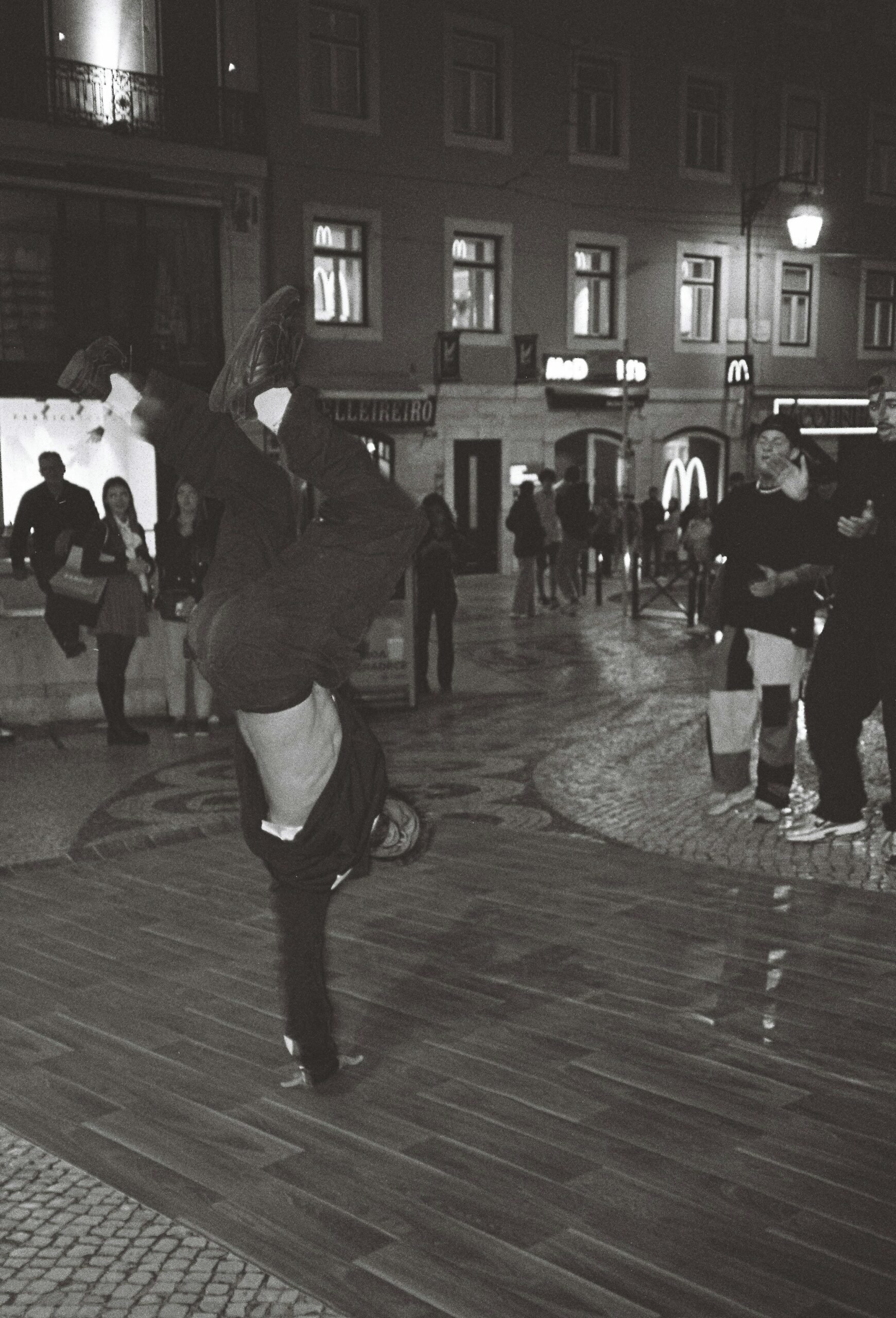
7. Contemporary
Contemporary dance emerged in the mid-20th century, breaking from classical ballet traditions. It emphasizes creativity and expression, blending elements from various dance styles. Originating in the United States and Europe, it sought to explore the body’s natural movement and the potential for artistic innovation.
The style of contemporary dance is fluid and versatile, characterized by its use of gravity, floor work, and improvisation. Dancers often utilize unconventional movements, challenging traditional dance norms. This freedom allows for personal expression and the exploration of complex emotions through movement.
Contemporary dance continues to evolve, influenced by cultural trends and advancements in choreography. It remains a dynamic and inclusive art form, welcoming diverse interpretations and innovative performances. Its emphasis on creativity and collaboration has made it a popular choice in both performance and educational settings.
In Lisbon, Portugal, Jazzy Dance Studios stands out for contemporary dance. Its classes cater to all skill levels. Another option is Dance Spot, known for its diverse dance offerings. Both studios are in central locations, making them easily accessible. They provide a vibrant environment for dancers to explore and refine their contemporary dance skills. Whether you’re a beginner or an experienced dancer, these studios offer a welcoming community.
Where to Learn Contemporary in Lisbon: Jazzy Dance and UDance also offer weekly contemporary classes. Companhia Nacional de Bailado offers contemporary dance master classes for dance students training to further their dance careers. Check their list of classes here.
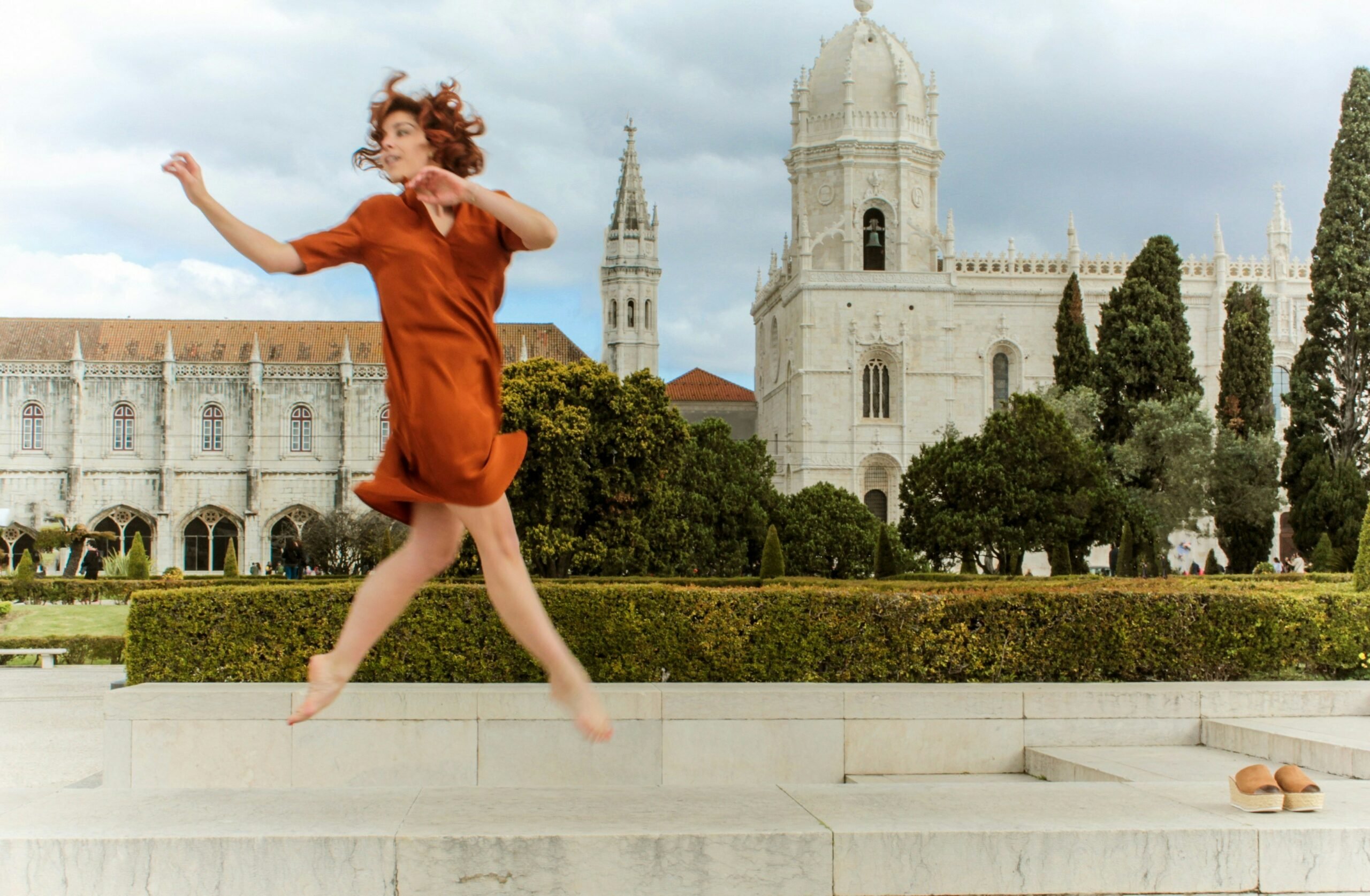
8. Ballroom
Ballroom dance originated in the 16th century from dances held in the royal courts. It was a symbol of social status and elegance. Over time, it evolved, incorporating folk dances. This blend created a rich diversity of styles.
Ballroom dance is characterized by its grace, fluidity, and precise movements. It includes both Standard and Latin styles. Standard focuses on smoothness and elegance. Latin emphasizes rhythm and passion.
In the 20th century, ballroom dance gained global popularity. Competitions and social dances spread its appeal. Today, it remains a cherished art form. It celebrates cultural heritage and personal expression through dance.
In Lisbon, Portugal, ballroom dancers find their rhythm at Jazzy Dance Studios, renowned for its diverse classes and vibrant community. Espaço Baião specializes in Latin dances, offering a warm, inviting atmosphere. For those seeking elegance, the Vintage Club combines classic charm with modern flair, hosting regular dance nights. Each venue caters to both beginners and seasoned dancers, making Lisbon a dance haven for enthusiasts of all levels.
Where to Learn Ballroom in Lisbon: Head over to Dance Spot, which has two locations in Lisbon (R. Fernando Vaz 10B and Rua Marquês de Fronteira 76A), and be treated to a mix of classical (English waltz, tango, Viennese waltz, slow fox and quickstep) and Latin (samba, cha cha cha, rumba, paso doble and jive). In addition to learning to dance various ballroom dances, the ear will become more flexible for recognizing and appreciating music.
Where to Dance Ballroom in Lisbon: In addition to the tango meetups from the TangoLX website, ask Dance Spot for the latest dance workshops and ballroom meetups happening around the city. The Facebook group Bachata@Lisboa also includes occasional announcements about ballroom dance events.
9. Swing
Swing dance originated in the 1920s and 1930s, evolving alongside the jazz music of that era. It began in African American communities, particularly in Harlem, New York. The Lindy Hop, one of the most famous swing dances, was named after Charles Lindbergh’s “hop” across the Atlantic.
Swing dance is characterized by its lively energy and improvisational nature. Dancers often include kicks, flips, and spins, making performances visually exciting. The dance emphasizes a strong connection between partners, allowing for seamless communication through movement.
Over the decades, swing dance has diversified into various forms, including the Charleston, Balboa, and West Coast Swing. Each style has its unique flair and movements, but all maintain the joyful spirit of the original swing dances. This adaptability has helped swing dance remain popular worldwide, celebrated in dance halls and competitions to this day.
Lisbon, Portugal, is a vibrant city with a lively swing dance scene. You can dance at venues like “Espaço Baião” and “Jazzy Dance Studios”. These spots host regular social dances and classes for all levels. Additionally, “Swing Station” organizes events and workshops. Each place offers a warm, welcoming atmosphere, perfect for dancers looking to swing the night away in Lisbon.
Where to Learn Swing Dance in Lisbon: Little Big Apple is the go-to place in Lisbon for swing dance enthusiasts, offering classes and workshops for dancers of all levels. BluesSwingLisboa (R. José Estêvão 45B) is another dance school that opened in 2020 and offers classes in Lindy Hop, Charleston, Blues, and Balboa.
Where to Swing Dance in Lisbon: Little Big Apple hosts Jam Sessions every other Saturday night from 9:30 pm-11:30 pm. Take advantage of the dance floor to dance Lindy Hop, Shag, Balboa, or Solo Jazz. Those who don’t dance or play any instrument are always welcome to enjoy the live music, have a drink, and make friends. The minimum donation is 3€ at the entrance.
BluesSwingLisboa (R. José Estêvão 45B) hosts a Balboa Social every Monday night at their school. From 4:00 pm- 6:00 pm on the first Sunday of every month, you can also attend an open swing and blues dance class followed by a free dance social at Cais do Sodré train station. Check out more events from BluesSwingLisboa here.
10. Pole Dance/Burlesque
Pole dance combines dance and acrobatics centered around a vertical pole. This performance art form takes roots in ancient fertility rituals and traditional Indian and Chinese circus acts. Over centuries, it evolved, blending cultural elements worldwide.
In the 1980s, pole dance gained popularity in Canada and the USA as a form of entertainment in strip clubs. This shift marked its commercial peak, diverging from its athletic and artistic origins. However, it retained its acrobatic essence and expressive potential.
Today, pole dance is recognized as a form of fitness and artistic expression. It embodies a mix of strength, flexibility, and dance, performed in various styles from exotic to contemporary. Its acceptance as a legitimate form of exercise and art highlights its dynamic evolution and versatile nature.
Sidenote: In conducting my research for this dance guide, I was surprised to discover the sheer variety and number of venues that teach pole dancing in Lisbon. As someone who has taken a pole dance class or two, I can say that pole dancing is one of the best workouts your body can get, requiring all of your muscles and a combination of rhythm, agility, and flexibility. If you haven’t tried it before, I encourage you to go for it! While it may not be a social dance, it will certainly teach you a thing or two about grit and determination.
Where to Learn Pole Dancing in Lisbon: In Lisbon, Portugal, Jazzy Dance Studios offers pole dance classes catering to all skill levels. Another option is A Pompadourette (R. Filipe Folque 1) next to Parque Eduardo VII. Brown Sugar Art ‘n’ Pole Dance Studio (Tv. Mercês 22A) in Bairro Alto trains students from all over the world and both men and women are welcome. Pole Dance Portugal offers a number of unique pole classes including Pole Sport, Pole Flow, Spinning Pole, and Low Flow. Finally, Jaya Lab not only offers pole dance but a range of other aerial arts including trapeze, rope, and aerial silks.
11. Belly Dance
Belly dance, a traditional Middle Eastern dance form, has roots stretching back to ancient civilizations. It originally served as a ritual to honor goddesses and for childbirth preparation. The dance was popularized in the West during the 19th century, particularly at the 1893 Chicago World’s Fair.
Characterized by fluid, sinuous movements, belly dance emphasizes the torso and hips. It incorporates intricate abdominal rolls, hip drops, and shimmies. The style varies by region, with Egyptian, Turkish, and Lebanese being prominent.
Over time, belly dance has evolved, blending traditional techniques with contemporary influences. It is now a global phenomenon, celebrated for both its artistic and cultural significance. Performances often feature elaborate costumes, enhancing the dance’s visual appeal and expressive nature.
Where to Learn Belly Dancing in Lisbon: Susana Amira offers belly dance classes in three different studios throughout the week in Sete Rios, Lumiar, and Algés. If you’re taking your very first belly dance class, attend the 7 pm Thursday evening class. Jazzy Dance Studios in Santos (the largest of the Jazzy Dance locations in Lisbon) offers one Level 2 Fusion Belly Dance class.
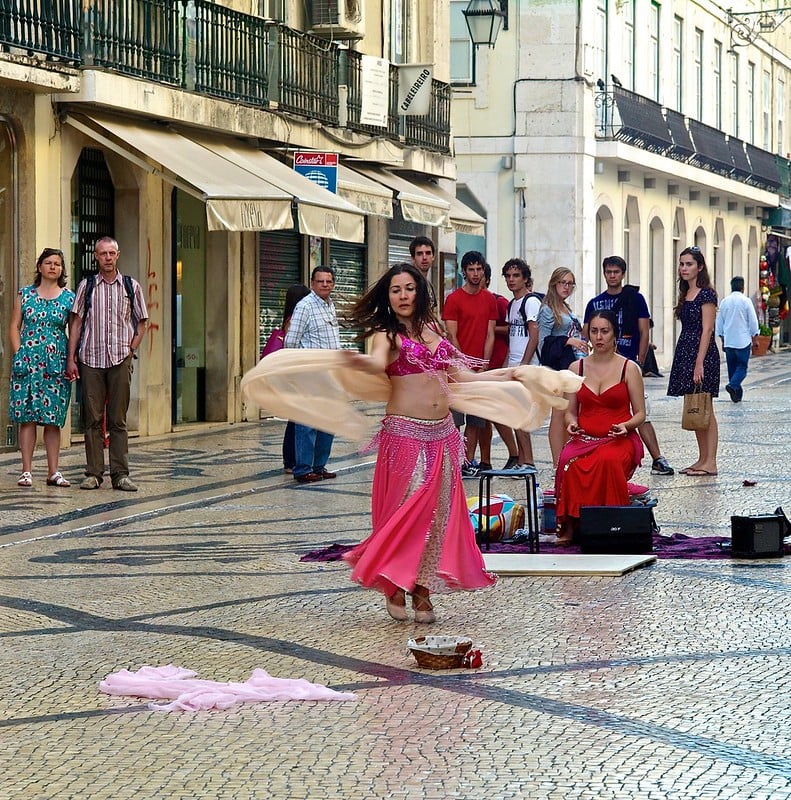
Final Thoughts
Lisbon’s dance scene is as vibrant and diverse as the city itself. Whether you’re drawn to the romantic rhythms of Bachata, the energetic steps of Salsa, or the traditional charm of Portuguese folk dance, Lisbon has something for every dancer. By joining classes, attending weekly meetups, and participating in community events, you’ll not only improve your dance skills but also immerse yourself in Lisbon’s buzzing dance community.
One final resource that we’d like to leave with you is Portal da Dança, which provides many different dance types and dance schools all in one place for the major cities in Portugal.
If you’re looking for a new way to connect in the city, put on your dancing shoes and check out one of Lisbon’s hundreds of dance classes.
